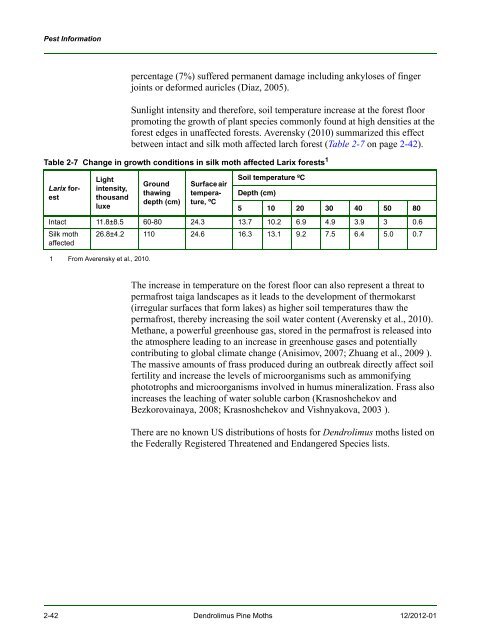New Pest Response Guidelines - aphis - US Department of Agriculture
New Pest Response Guidelines - aphis - US Department of Agriculture
New Pest Response Guidelines - aphis - US Department of Agriculture
Create successful ePaper yourself
Turn your PDF publications into a flip-book with our unique Google optimized e-Paper software.
<strong>Pest</strong> Information<br />
percentage (7%) suffered permanent damage including ankyloses <strong>of</strong> finger<br />
joints or deformed auricles (Diaz, 2005).<br />
Sunlight intensity and therefore, soil temperature increase at the forest floor<br />
promoting the growth <strong>of</strong> plant species commonly found at high densities at the<br />
forest edges in unaffected forests. Averensky (2010) summarized this effect<br />
between intact and silk moth affected larch forest (Table 2-7 on page 2-42).<br />
Table 2-7 Change in growth conditions in silk moth affected Larix forests 1<br />
Larix forest<br />
Light<br />
intensity,<br />
thousand<br />
luxe<br />
Ground<br />
thawing<br />
depth (cm)<br />
Surface air<br />
temperature,<br />
ºC<br />
Soil temperature ºC<br />
Depth (cm)<br />
5 10 20 30 40 50 80<br />
Intact 11.8±8.5 60-80 24.3 13.7 10.2 6.9 4.9 3.9 3 0.6<br />
Silk moth<br />
affected<br />
26.8±4.2 110 24.6 16.3 13.1 9.2 7.5 6.4 5.0 0.7<br />
1 From Averensky et al., 2010.<br />
The increase in temperature on the forest floor can also represent a threat to<br />
permafrost taiga landscapes as it leads to the development <strong>of</strong> thermokarst<br />
(irregular surfaces that form lakes) as higher soil temperatures thaw the<br />
permafrost, thereby increasing the soil water content (Averensky et al., 2010).<br />
Methane, a powerful greenhouse gas, stored in the permafrost is released into<br />
the atmosphere leading to an increase in greenhouse gases and potentially<br />
contributing to global climate change (Anisimov, 2007; Zhuang et al., 2009 ).<br />
The massive amounts <strong>of</strong> frass produced during an outbreak directly affect soil<br />
fertility and increase the levels <strong>of</strong> microorganisms such as ammonifying<br />
phototrophs and microorganisms involved in humus mineralization. Frass also<br />
increases the leaching <strong>of</strong> water soluble carbon (Krasnoshchekov and<br />
Bezkorovainaya, 2008; Krasnoshchekov and Vishnyakova, 2003 ).<br />
There are no known <strong>US</strong> distributions <strong>of</strong> hosts for Dendrolimus moths listed on<br />
the Federally Registered Threatened and Endangered Species lists.<br />
2-42 Dendrolimus Pine Moths 12/2012-01

















